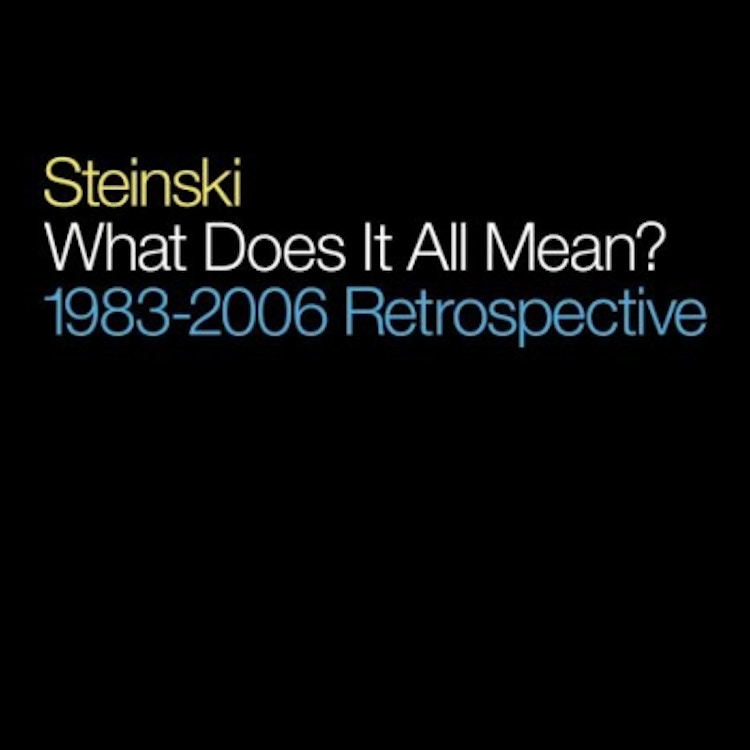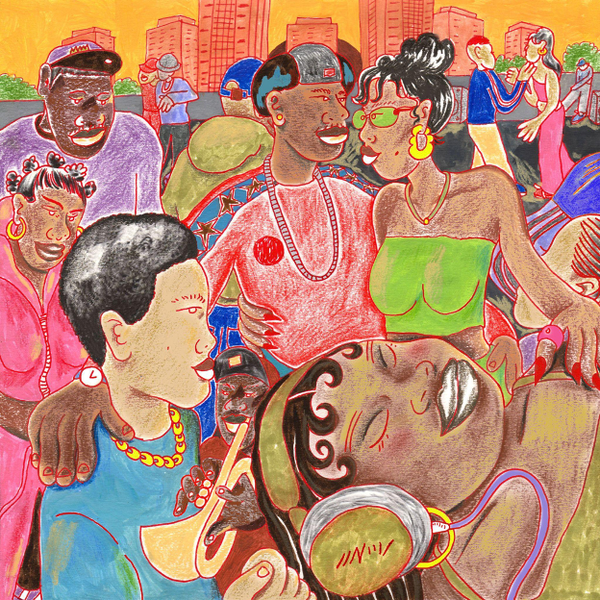"What Does It All Mean? 1983-2006 Retrospective"

22 October 2008, 10:00
| Written by Simon Tyers
 In the same way there's a school of thought that NWA and then the East/West Coast feud ruined rap because what was going on before then was far more interesting as those involved had nothing to prove to their peers and listeners other than innovating and the art of showing off, sample culture thrived in its infancy because it was all about laboriously cutting and pasting from multiple sources to make something totally new aimed squarely at the chiefly New York dancefloors at a time when, to be frank, their legality was more openly dubious, until a series of court decisions around 1992 changed the producer's showing off palette for good. Collage styled production never went away, but ask any number of those in the business for more than slapping down an 80s AOR hit over a simple dance beat and getting their label to hire some dancers for the video - from Prince Paul and the Dust Brothers to the Avalanches and Girl Talk - and they'll doff the hat to one man. True, 'The Adventures Of Grandmaster Flash On The Wheels Of Steel' had already invented the megamix of existing records by the time he started out, but Steve Stein, AKA Steinski, was the first man to really work out that sampled breakbeats and snippets could be merged together rather than looped and scratched into a whole new work that still referenced and fitted into the nascent hip-hop spectrum. What Does It All Mean?, issued by intellectual property boundary pushing label Illegal Art (also home of Girl Talk), documents more than twenty years of his work.And it started almost by accident - Stein, working in advertising at the time, and his sound engineer friend Douglas 'Double Dee' Di Franco were avid record collectors old enough to have followed hip hop from its initial stirrings towards the end of the 70s, and in 1983 when Tommy Boy Records held a national competition to come up with a homemade remix of 'Play That Beat, Mr. D.J.' by Afrika Bambaataa proteges G.L.O.B.E. and Whiz Kid they saw their chance, utilising their knowledge and Double Dee's editing skills to blend songs together, slapping extra samples on top until the old tunes coalesced into a new whole which still referred to the original track. It won, unsurprisingly, but the seamless source reassembly with spot-on timing of what became known as 'Lesson 1 - The Payoff Mix' came to have much more cachet than passing interest. The sheer breadth of sources they chose to work with is what makes it stand out, going beyond hip hop's then set texts of funk and disco to grab from all sorts of soul, pop and even Humphrey Bogart and dance instructional records as well as embryonic rap itself. Even in this digital editing era it still sounds impressive - no modern samplers or ProTools, remember, all splicing two inch tape by hand - as do the duo's two casually arranged follow-ups, Fatboy Slim record box regular 'Lesson 2 (James Brown Mix)' harvesting a similar selection of smart samples propelled by some of the JB's most famous breaks, while 'Lesson 3 (History Of Hip Hop)' collages and deconstructs some of the breakbeats the genre was already building itself on alongside politicians and Groucho Marx. All three on their own would prop up twenty five plus years of kaleidoscopic sampling culture; all three also end with "say, children, what does it all mean?, a political soundbite sample itself much reused since, not least on the seperate tributes titled 'Lesson 4' by modern fellow travellers DJ Shadow and Cut Chemist. Long available only as much prized bootlegs or off-air radio recordings, to have them all in one place on CD acts as its own sales pitch. Even if you've never heard them, which is more than likely, you'll recognise decent swathes of the works plundered from them.But that's far from all. Although Steinski made two more tracks with Double Dee in the late 90s, Afrika Bambaataa remix 'Jazz' and the superior Sugar Hill Record archive digging 'Voice Mail', both working to the same attention deficit dead-on tape splicing methodology retaining groove, beats and humour alike, Stein spent most of the period after 1984 developing in his own field and even ended up on a major label for a while - the radio advertising cutup 'We'll Be Right Back', along with the at the time heavily NME feted 'The Motorcade Sped On' arguably his most famous post-Lessons work, is absent for that reason. As well as improving his stylised flow and turntablism Steinski was able to use the format for ends that extended far beyond record collector hip-hop. 'The Motorcade Sped On' is a remarkable work in its own way, constructed from news reports and reportage of Kennedy's assassination as well as touches around the edges - contemporary cultural samples, sirens, The Last Post - that make it all the more affecting without trivialising events. In this age of Breaking News tickers and TV reporters on 24 hour standby the mess of countering voices you'd be forgiven for thinking its very construction in 1986 was more prescient than Stein could have imagined. There's also no evident satirical side to its historical reporting, which is very much not the case with 'It's Up To You (Television Mix)', juxtaposing the first George Bush's State Of The Union Address during the first Gulf War with appropriate spoken samples without coming across as politically hectoring, managing to sound playful while undermining so many layers of the original intentions. Continuing in this stream is new track - yes, even these sorts of best ofs get a new track nowadays - 'Number Three On Flight Eleven'. A complete change of pace from the largely party jams before, it movingly if unsettlingly juxtaposes ambient drones and poetry readings with a recording of a call to ground control by Betty Ong, a flight attendant who was on board the American Airlines plane that was hijacked and flown into the North Tower of the World Trade Centre. Almost an art piece rather than music, it fits into a small but significant category, also inhabited by Suicide's 'Frankie Teardrop' and the Special AKA's 'The Boiler', of fine works that you'll never want to hear twice.The rest of the first CD passes muster, especially the retro box digging of 'Ain't No Thing' which could have been an alternate Lesson, but the other selling point of the collection covers CD 2. 'Nothing To Fear', originally pieced together in 2002 for Solid Steel, the then BBC London radio show of another artist he heavily inspired, Coldcut, is a 59 minute mix that took Steinski eighteen months beginning to end to piece together, mixing a Marvin Gaye instrumental as well as the likes of Timbaland, De La Soul, Nelly and Moloko with cuts from well back in the crate. Showcasing fine turntable skills and the traditional judiciously placed samples and cut-up half recognisable moments - a decent portion of John Martyn's hardly block party friendly 'Solid Air' turns up at one point - even when, as is inevitable for a continuous mix of that length, it slumps a little you're never far away from a surprise or earcatching moment.Listening to this collection as a whole, you can't help thinking that as much as some of the beats have dated there's something very human about cut and paste sample collages from the days well before ProTools, and that no shortage of more immediately feted names have queued up to pay homage to the originator is indicative of the enduring quality of these methodically inventive, endlessly entertaining and, yes, danceable end results. It's not exaggeration to say that a lot of beatmaking traces it roots back to these works, and in particular the three unwhackable history lessons that open up.
92%Illegal Art Records
In the same way there's a school of thought that NWA and then the East/West Coast feud ruined rap because what was going on before then was far more interesting as those involved had nothing to prove to their peers and listeners other than innovating and the art of showing off, sample culture thrived in its infancy because it was all about laboriously cutting and pasting from multiple sources to make something totally new aimed squarely at the chiefly New York dancefloors at a time when, to be frank, their legality was more openly dubious, until a series of court decisions around 1992 changed the producer's showing off palette for good. Collage styled production never went away, but ask any number of those in the business for more than slapping down an 80s AOR hit over a simple dance beat and getting their label to hire some dancers for the video - from Prince Paul and the Dust Brothers to the Avalanches and Girl Talk - and they'll doff the hat to one man. True, 'The Adventures Of Grandmaster Flash On The Wheels Of Steel' had already invented the megamix of existing records by the time he started out, but Steve Stein, AKA Steinski, was the first man to really work out that sampled breakbeats and snippets could be merged together rather than looped and scratched into a whole new work that still referenced and fitted into the nascent hip-hop spectrum. What Does It All Mean?, issued by intellectual property boundary pushing label Illegal Art (also home of Girl Talk), documents more than twenty years of his work.And it started almost by accident - Stein, working in advertising at the time, and his sound engineer friend Douglas 'Double Dee' Di Franco were avid record collectors old enough to have followed hip hop from its initial stirrings towards the end of the 70s, and in 1983 when Tommy Boy Records held a national competition to come up with a homemade remix of 'Play That Beat, Mr. D.J.' by Afrika Bambaataa proteges G.L.O.B.E. and Whiz Kid they saw their chance, utilising their knowledge and Double Dee's editing skills to blend songs together, slapping extra samples on top until the old tunes coalesced into a new whole which still referred to the original track. It won, unsurprisingly, but the seamless source reassembly with spot-on timing of what became known as 'Lesson 1 - The Payoff Mix' came to have much more cachet than passing interest. The sheer breadth of sources they chose to work with is what makes it stand out, going beyond hip hop's then set texts of funk and disco to grab from all sorts of soul, pop and even Humphrey Bogart and dance instructional records as well as embryonic rap itself. Even in this digital editing era it still sounds impressive - no modern samplers or ProTools, remember, all splicing two inch tape by hand - as do the duo's two casually arranged follow-ups, Fatboy Slim record box regular 'Lesson 2 (James Brown Mix)' harvesting a similar selection of smart samples propelled by some of the JB's most famous breaks, while 'Lesson 3 (History Of Hip Hop)' collages and deconstructs some of the breakbeats the genre was already building itself on alongside politicians and Groucho Marx. All three on their own would prop up twenty five plus years of kaleidoscopic sampling culture; all three also end with "say, children, what does it all mean?, a political soundbite sample itself much reused since, not least on the seperate tributes titled 'Lesson 4' by modern fellow travellers DJ Shadow and Cut Chemist. Long available only as much prized bootlegs or off-air radio recordings, to have them all in one place on CD acts as its own sales pitch. Even if you've never heard them, which is more than likely, you'll recognise decent swathes of the works plundered from them.But that's far from all. Although Steinski made two more tracks with Double Dee in the late 90s, Afrika Bambaataa remix 'Jazz' and the superior Sugar Hill Record archive digging 'Voice Mail', both working to the same attention deficit dead-on tape splicing methodology retaining groove, beats and humour alike, Stein spent most of the period after 1984 developing in his own field and even ended up on a major label for a while - the radio advertising cutup 'We'll Be Right Back', along with the at the time heavily NME feted 'The Motorcade Sped On' arguably his most famous post-Lessons work, is absent for that reason. As well as improving his stylised flow and turntablism Steinski was able to use the format for ends that extended far beyond record collector hip-hop. 'The Motorcade Sped On' is a remarkable work in its own way, constructed from news reports and reportage of Kennedy's assassination as well as touches around the edges - contemporary cultural samples, sirens, The Last Post - that make it all the more affecting without trivialising events. In this age of Breaking News tickers and TV reporters on 24 hour standby the mess of countering voices you'd be forgiven for thinking its very construction in 1986 was more prescient than Stein could have imagined. There's also no evident satirical side to its historical reporting, which is very much not the case with 'It's Up To You (Television Mix)', juxtaposing the first George Bush's State Of The Union Address during the first Gulf War with appropriate spoken samples without coming across as politically hectoring, managing to sound playful while undermining so many layers of the original intentions. Continuing in this stream is new track - yes, even these sorts of best ofs get a new track nowadays - 'Number Three On Flight Eleven'. A complete change of pace from the largely party jams before, it movingly if unsettlingly juxtaposes ambient drones and poetry readings with a recording of a call to ground control by Betty Ong, a flight attendant who was on board the American Airlines plane that was hijacked and flown into the North Tower of the World Trade Centre. Almost an art piece rather than music, it fits into a small but significant category, also inhabited by Suicide's 'Frankie Teardrop' and the Special AKA's 'The Boiler', of fine works that you'll never want to hear twice.The rest of the first CD passes muster, especially the retro box digging of 'Ain't No Thing' which could have been an alternate Lesson, but the other selling point of the collection covers CD 2. 'Nothing To Fear', originally pieced together in 2002 for Solid Steel, the then BBC London radio show of another artist he heavily inspired, Coldcut, is a 59 minute mix that took Steinski eighteen months beginning to end to piece together, mixing a Marvin Gaye instrumental as well as the likes of Timbaland, De La Soul, Nelly and Moloko with cuts from well back in the crate. Showcasing fine turntable skills and the traditional judiciously placed samples and cut-up half recognisable moments - a decent portion of John Martyn's hardly block party friendly 'Solid Air' turns up at one point - even when, as is inevitable for a continuous mix of that length, it slumps a little you're never far away from a surprise or earcatching moment.Listening to this collection as a whole, you can't help thinking that as much as some of the beats have dated there's something very human about cut and paste sample collages from the days well before ProTools, and that no shortage of more immediately feted names have queued up to pay homage to the originator is indicative of the enduring quality of these methodically inventive, endlessly entertaining and, yes, danceable end results. It's not exaggeration to say that a lot of beatmaking traces it roots back to these works, and in particular the three unwhackable history lessons that open up.
92%Illegal Art Records
Get the Best Fit take on the week in music direct to your inbox every Friday
Read next
News
Listen
Merpire pays homage to friendship in the scuzzy garage rock track “Fishing”
Kindelan embarks on an ambitious double single project
The tumultuous tornado of Max Baby’s “I Can Do Anything”
Southern rapper sosocamo blends the ethereal and the brash in “Chronic”
There's a new idol to worship, and he goes by Cain Culto
meg elsier puts pedal to the slacker metal on “sportscar [scrapped]”
Reviews

Wet Leg
moisturizer
11 Jul 2025

MF Tomlinson
Die To Wake Up From A Dream
10 Jul 2025

BIG SPECIAL
National Average
10 Jul 2025

Gwenno
Utopia
09 Jul 2025




